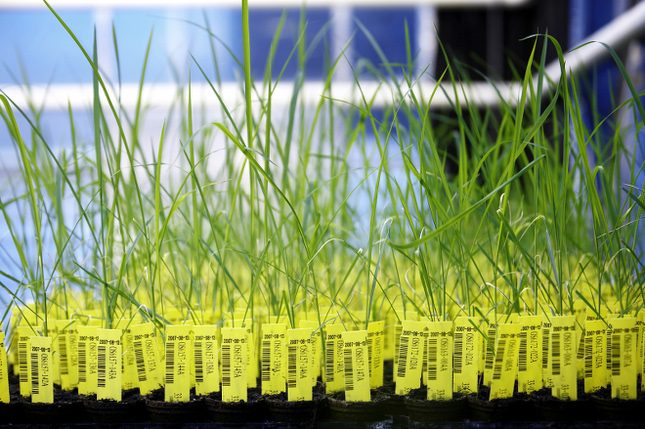Farmers’ seed systems, in the light of an alternative
The autonomy of peasant seed systems is a founding element of the agro-ecological shift. Guy Kastler and Antonio Onorati, members of La Via Campesina, use examples to demonstrate the importance of peasant seeds in this movement.
Farmers’ seed systems are not a vague aspiration of the ”custodians” of local varieties. Nor are they the aspiration of producers’ organisations looking for economic niches in which to sell agricultural products under the pretext of sophisticated, luxury marketing. It’s a dynamic reality, constantly “innovating”. The data confirms this.
Farm-saved seeds : living and effective systems
Farmers’ seed systems, despite the attacks they face from the seed industry and public policy, remain alive and able to function effectively. In many countries, such systems are “illegal“. They nevertheless weigh on the agricultural economy, even if they are constantly asked to demonstrate this reality. Here we provide data and assessments of the effectiveness of such systems in terms of food security and sovereignty.
The seed industry distinguishes between “illegal” seeds (farmers’ seeds) and “legal” seeds (certified seeds). It is possible to estimate the respective weight of the two seed systems in a country’s agricultural production. To do this, we need to highlight the counterpart of ’illegal’ seeds, i.e. the extent to which ’legal’ seeds are used. We also present data from sample surveys, many of which are part of academic research. These are obviously partial data, but they concern the most widespread crops, such as cereals, and this is precisely what makes them so important. These crops are indeed the most relevant economically, and are the ones on which the seed industry is concentrating its efforts to impose its certified seed system.
Certified seeds are not always popular
From one region to another, we can see that the use of ’legal’ certified seed is not necessarily in the majority. They are sometimes much less widely used than ’illegal’ farmers’ seed.
In 2020, the use of certified seed for horticulture in Africa represented 1.1% in Mali, 1.4% in Mozambique, 2.1% in Senegal, 4.9% in Côte d’Ivoire, 11.7% in Nigeria and 14.3% in Ethiopia. With 31.2%, it is Kenya that uses certified seed the most [1]. More generally, according to the various statements made by seed companies, on average less than 20% of cultivated land in Africa is sown with certified varieties.
In Europe, according to a Euroseeds report dated 19 November 2020, certified seed accounts for 54% of cultivated land for grain maize and 46% for silage maize [2]. For winter-sown wheat, certified seed accounts for 60%, and only 0.5% is hybrid seed. For all the data presented, however, the report states that, according to farmers’ responses, the reality is much lower. In other words, the use of certified seed is lower than these figures.
Kazakhstan is a major wheat exporter in Central Asia. Agriculture is one of its main economic drivers [3]. An international team used data from household surveys conducted in the country’s northern region between April and June 2019 [4]. Over 74% of this area is suitable for agricultural production. It guarantees 80% of the country’s wheat production. Although several certified wheat varieties have been released by the Red Fall experimentation station since 2000, the adoption of certified varieties in the experimentation as a whole does not exceed 40% on average. In other words, in the most ecologically favourable wheat-growing zone in the country, at least 60% of farmers will continue to use their own seeds because they “judge them to be more profitable“. These results are all the more convincing given that the study specifies that the process “is carried out in strict compliance with the guidelines and only the producers formally registered in the seed register can take part“. In other words, those who are a priori inclined to adopt certified varieties.
Farmers’ seeds : quality, adaptability and profitability
A number of research studies report that, throughout the world, farmers’ seeds are not always perceived as being of inferior quality to certified varieties. This is shown by an Asian study on wheat. Bangladeshi farmers selected certified wheat varieties that had a theoretical yield advantage of at least 10% over farmers’ varieties [5]. The study points out that “the absence of detectable yield differences between certified and traditional varieties was considered to be the main determining factor of the non-adoption [by farmers] of improved varieties“.
In West Africa, the tomato industry makes a significant contribution to the nutritional status and livelihoods of farmers. A study by Ghanaian researcher Adinan Shafiwu concludes : “despite important investment in the tomato sector by successive governments through the establishment of a number of tomato processing plants, the certified varieties that should guarantee the quality and quantity of tomatoes required for commercial processing are not grown, with farmers preferring to cultivate local varieties“ [6]. This study, initially devoted to proving the superior quality of certified varieties, ultimately shows the persistence of farmers in using their peasant varieties, which they consider to be superior, including for industrial processing.
A report on the use of peasant seeds in Latin America was published in November 2019 by the NGO Swissaid (Swiss Foundation for Development Cooperation) [7]. It highlights the important role played by community seed banks in countries such as Nicaragua and Colombia. These banks work with open-pollinated local varieties (whose seeds can be used for reseeding), enabling ecological agriculture adapted to climate change. The report adds : “hybrid or genetically modified seeds are not accepted in community seed banks. Most Colombian and Nicaraguan farmers have always had bad experiences with certified industrial seeds (e.g. poor germination capacity). Although these are often distributed free of charge through governmental incentive programmes, they are generally unsuited to local environmental conditions“.
In Mexico, the use of certified maize seed is less than 60% of the area sown, and the same applies to beans. According to the Oleaginosas website : “Two of the most important crops in the Mexican diet [maize and beans] have a low rate of adoption of improved certified seed“ [8]. In addition to the high quality of peasant seeds, this can be explained by the fact that indigenous peoples, who are very important to Mexico’s social and agricultural network, are historically keen on using such seeds and remain suspicious of certified, standardised varieties.
According to a 2016 survey on the seed industry in France, the European Union’s leading wheat producer, “half of the acreage [is grown] with certified seed“ [9]. The other half is therefore cultivated with seeds grown by farmers themselves, farm-saved seeds (i.e. certified seeds reproduced on the farm) or seeds grown by farmers.
In short, a range of data on examples of crops that are very important in food or economic terms confirms not only resistance to the adoption of certified varieties, but also the ability of farmers’ seed to dominate important sectors of a country’s agricultural economy. It also proves that there is an economic reason for using seeds from the farmers’ system.














